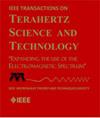一种用于Sub-THz宽带收发器的InP分布式有源隔离器,在215ghz带宽上具有> - 30db隔离
IF 3.9
2区 工程技术
Q2 ENGINEERING, ELECTRICAL & ELECTRONIC
IEEE Transactions on Terahertz Science and Technology
Pub Date : 2025-03-12
DOI:10.1109/TTHZ.2025.3550802
引用次数: 0
摘要
本文提出了一种5 - 220 ghz有源隔离器,具有bbb50至>30db的反向隔离,用于保护亚太赫兹宽带收发器中的本地振荡器。隔离器设计采用由5个高隔离级组成的达灵顿分布式放大器拓扑结构,实现平坦正向传输和宽带输入/输出匹配。为了实现跨宽带的高隔离,隔离器共同设计了堆叠异质结双极晶体管(HBT)拓扑结构和高隔离布局结构,为整个隔离器构建了高隔离级。采用低串扰传输线、高隔离单元屏蔽和具有连续地平面的共面波导的新布局布置提出并实施,以减轻在次太赫兹频率下严重降低隔离的耦合。制备了磷化铟活性隔离器并对其进行了表征。该样机的正向增益为10 dB,反向隔离度分别为bbb50、bbb37和bbb30 dB,最高可达40、190和220 GHz。最大饱和功率为15.8 dBm,输出1db压缩点为12.2 dBm。在120 ~ 170 GHz范围内,输出三阶截距为21.4 ~ 16.1 dBm。隔离器消耗45 mA电流,有效面积为0.176 mm2。本文章由计算机程序翻译,如有差异,请以英文原文为准。
An InP Distributed Active Isolator With >30-dB Isolation Over 215-GHz Bandwidth for Sub-THz Wideband Transceivers
This article presents a 5–220-GHz active isolator with >50 to >30 dB reverse isolation to protect local oscillators in sub-THz wideband transceivers. The isolator design adopts a Darlington distributed amplifier topology comprised of five high-isolation stages to achieve a flat forward transmission and wideband input/output matchings. To achieve a high isolation across the wide bandwidth, the isolator codesigns stacked heterojunction bipolar transistor (HBT) topology and high-isolation layout structures, building high-isolation stages for the complete isolator. A new layout arrangement using low-crosstalk transmission lines, high-isolation cell shielding, and coplanar waveguides with continuous ground planes is presented and implemented to mitigate couplings that severely degrade isolation at sub-THz frequencies. The indium phosphide active isolator is fabricated and characterized. The prototype exhibits a forward gain of 10 dB and a reverse isolation of >50, >37, and >30 dB up to 40, 190, and 220 GHz, respectively. The maximum saturated power and the output 1-dB compression point are 15.8 and 12.2 dBm, respectively. From 120 to 170 GHz, the output third-order intercept point is from 21.4 to 16.1 dBm. The isolator consumes 45 mA of current with an active area size of 0.176 mm2.
求助全文
通过发布文献求助,成功后即可免费获取论文全文。
去求助
来源期刊

IEEE Transactions on Terahertz Science and Technology
ENGINEERING, ELECTRICAL & ELECTRONIC-OPTICS
CiteScore
7.10
自引率
9.40%
发文量
102
期刊介绍:
IEEE Transactions on Terahertz Science and Technology focuses on original research on Terahertz theory, techniques, and applications as they relate to components, devices, circuits, and systems involving the generation, transmission, and detection of Terahertz waves.
 求助内容:
求助内容: 应助结果提醒方式:
应助结果提醒方式:


